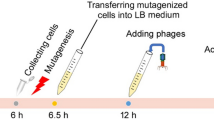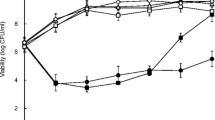Abstract
Heat treatment was used to reduce the number ofStaphylococcus aureus strains that were not typable with the basic set of phages. All strains were phage typed according to the standard method after growth in broth at 37 °C or 48 °C. Forty-eight of 72 non-typable strains could be phage typed after heat treatment of the bacterial cultures. The page lysability increased with the higher incubation temperature of the broth, but the mean variability in the phage pattern of a strain was not significantly affected. The phage typing results of strains sampled over a period of several months were in accordance with the epidemiology, suggesting that phage typing after incubation at 48 °C is a stable and useful epidemiological tool.
Similar content being viewed by others
References
Blair, J. E., Williams, R. E. O. Phage typing of staphylococci. Bulletin of World Health Organisation 1961, 24: 771–784.
Parker, M. T. The significance of phage-typing patterns inStaphylococcus aureus. In: Easmon, C. S. F., Adlam, C. (ed.): Staphylococci and staphylococcal infections. Academic Press, London, 1983, p. 33–62.
Martin-Bourgon, C., Berrón, S., Casal, J. Hospital infection caused by non-typableStaphylococcus aureus: application of reverse typing. Journal of Hygiene 1985, 94: 201–204.
Altemeier, W. A., Lewis, S. A., Bjornson, H. S., Staneck, J. L., Schlievert, P. M. Staphylococcus in toxic shock syndrome and other surgical infections. Archives of Surgery 1983, 118: 281–284.
Dowsett, E. G., Petts, D. N., Baker, S. L., DeSaxe, M. J., Coe, A. E., Naidoo, J., Noble, W. C. Analysis of an outbreak of staphylococcal scalded skin syndrome: strategies for typing “non-typable” strains. Journal of Hospital Infection 1984, 5: 391–397.
Dua, M., Agarwal, D. S., Natarajan, R. Phage-typing ofStaphylococcus aureus using phages other than those of basic set and new methods. Indian Journal of Medical Research 1982, 75: 348–354.
Pisano, M. A., Ball, D. J., Eriques, L. Temperature-related variations in the lipid composition of methicillin-susceptibleStaphylococcus aureus strains. Journal of Clinical Microbiology 1983, 17: 1170–1172.
Nordstrom, K., Forsgren, A. Effect of protein A on adsorption of bacteriophages toStaphylococcus aureus. Journal of Virology 1974, 14: 198–202.
Frost, A. J., Bradshaw, E. The role of lysogeny in the modification of phage typing pattern ofStaphylococcus aureus from dairy cows. Journal of Hygiene 1980, 85: 301–307.
Author information
Authors and Affiliations
Rights and permissions
About this article
Cite this article
Lundholm, M., Bergendahl, B. Heat treatment to increase phage typability ofstaphylococcus aureus . Eur. J. Clin. Microbiol. Infect. Dis. 7, 300–302 (1988). https://doi.org/10.1007/BF01963107
Issue Date:
DOI: https://doi.org/10.1007/BF01963107




